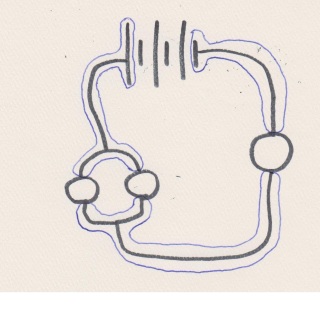Originally Posted: 1-15-13
The new version of the NGSS are out and being reviewed by the public. Science teachers in our district will have in-service time on Monday to look at them and comment. It is a very exciting time. I like the standards, I really like the 8 science/engineering practices. I plan to watch the NSTA webinars “soon”.
But one of the practices, Arguing from Evidence, can’t wait. In CASTLE (materials for learning about electricity) students are asked to change their way of thinking about circuits, their personal model, based on what they see happening as they build various simple circuits. The program does a great job in general of presenting ideas in an orderly way. But models are like a tangle of yarn. It’s hard to find an end to pull on.
On the first day, students use a compass to provide evidence that something is going on in the wires. Since the compasses under each wire in a circuit connecting two similar bulbs in series to a battery pack all deflect in the same direction and by the same amount, students are expected to conclude that the charge moving in wires (current) travels in a single direction, not different directions in different wires.
If someone had told me this on the first day I studied circuits in high school, I think I would have been years ahead. I could never figure out how you knew which way charge would flow in a wire and apparently no one thought to teach me.
Students are also to observe that both bulbs seem to light at the same time and to conclude that charge must be already be present in all parts of the circuit, rather than being supplied by the battery (an extremely common misconception).
But some of the new ideas we ask students to accept without direct evidence.
1. That a compass moves because charge moves in the wire.
2. That the drift speed of charge is much less than students think (cms/sec instead
As I tried to explain to students what “evidence” was it became apparent to me that I didn’t exactly know. I kind of knew if something felt like evidence to me, but that wasn’t good enough. The first sign that something good was happening was that one group of students challenged me about the basic ideas I had asked them to accept. Sort of like geometry where you have to start with “the shortest distance between two points is a straight line”. If that turns out not to be true, them all that follows may not be true.
For the first point, compasses responding to moving charge, I set out to find a demonstration that I could use to show students that moving charges affect the position of a compass while stationary charges do not. Since I had batteries handy, I thought I would use the positive terminal of a battery as the charge. It is a little embarrassing to admit I was so unsophisticated in my thinking. Of course the needle of the compass was attracted to the battery whether it was moving or not. The same thing would have happened with a fork, which was clearly not charged. So I needed to find an object that could be charged but was not metal. How about styrene? I charged up a piece of foam by friction, and ran past a compass. I was hoping that the compass would stay put if I held the foam stationary near it and deflect in some way if the foam were moved under the compass.It did! See video:

The second challenge, drift speed, sent me to the internet to see how this velocity was measured. There was a great deal of discussion about how it was calculated and the calculation made sense so I have posted this calculation for any student who felt compelled to inquire. If you have any suggestions for how I can convince students that charge moves this slowly in metal wire, let me know.
Update to this post: (1-23-13)
This picture (below) is associated with one of the comments below. It shows an attempt to encircle portions of the circuit that have the same potential. Like color coding it makes the understanding of the circuit more simple. I wish I had recognized the powerful nature of this type of analysis years ago when a student showed this to me.


